- Home
- Richard F. Weyand
EMPIRE: Conqueror (EMPIRE SERIES Book 6)
EMPIRE: Conqueror (EMPIRE SERIES Book 6) Read online
Books in the EMPIRE Series
by Richard F. Weyand:
EMPIRE: Reformer
EMPIRE: Usurper
EMPIRE: Tyrant
EMPIRE: Commander
EMPIRE: Warlord
EMPIRE: Conqueror
Books in the Childers Universe
by Richard F. Weyand:
Childers
Childers: Absurd Proposals
Galactic Mail: Revolution
A Charter For The Commonwealth
Campbell: The Problem With Bliss
by Stephanie Osborn:
Campbell: The Sigurdsen Incident
EMPIRE
Conqueror
by
RICHARD F. WEYAND
Copyright 2019 by Richard F. Weyand
All Rights Reserved
ISBN 978-1-7340758-0-9
Printed in the United States of America
Cover Credits
Cover Art: James Lewis-Vines
Interior Ship Drawings: James Lewis-Vines
Back Cover Photo: Oleg Volk
Published by Weyand Associates, Inc.
Bloomington, Indiana, USA
October 2019
CONTENTS
An Eerie Calm
The DP Prepares
First Moves
Operation Cupboard
Operation Roaches
Operation Houdini
Operation Sitting Duck
Planning The Peace
A New Strategy
Operations Flying Duck & Booby Trap
Operation Butterfly Net
Operation Potshot
Cache 32 Revisited
War Crime
Reaction To Balmoral
Political Upheaval
Rescue Mission
A New Majority
A Fateful Decision
Another Fateful Decision
Olympia
Surrender
Returning Home
Warnings
Covert Op
Counter-Intelligence
Rolling Up The Spy Ring
District Governors
The Turn Of The Card
Building the Peace
Lots of Meetings
More Meetings
Governors and Governments
Coronation
From the Encyclopedia Hominum
Author’s Afterword
An Eerie Calm
“I think you should give Admiral Conroy a war warning, Bobby.”
“Really?” Dunham asked. “Things seem to have calmed down since Jasmine.”
They’d had dinner with the kids, then sat in the living room of the family apartment – the kids’ playroom – watching the kids play with their toys, for a quiet evening at home.
The twins had been put to bed, and they had retired back to the private living room of the Imperial Apartment next door. The drapes, sheers, and glass wall had been opened on this pleasant evening, and the view down Palace Mall, surrounded first by the low-rise buildings of Imperial Park and then by the skyscrapers of Imperial City, was magnificent.
“I think it’s the calm before the storm.”
“Why do you say that? What are you seeing?”
“Well, you know I’ve been monitoring all the political news coming out of the capital of the Democracy of Planets. The prime minster – Harold Pinter – and his government have been hard-pressed by the opposition for the last several years. Part of that is our fault, in at least one sense. With the Empire’s economy going so well, we’ve been out-innovating and out-producing the DP, and it’s hurt their export markets.
“In response, and without telling their public, they engineered hostility between the independent star nations and the Empire, hoping to hurt our export market and take up the slack. I don’t think they wanted a war, but it got out of hand. At the same time, in order to be consistent with what they were telling the independent star nations, they were peddling anti-Sintar sentiment at home. They started getting pushback from the opposition to do something about what they called the Sintar problem.”
“And then we beat the Alliance.”
“Yes, and in a shockingly fast and complete way. Nobody had thought through what total war between such large belligerents was going to be like, and they weren’t ready for it. Millions of destroyed ships, billions of dead spacers. Without sufficient navies remaining to protect themselves from either the DP or each other, the independents came crashing down, many of them annexing to the Empire for defense in what must have seemed a crazy move to people who had made Sintar out to be the bad guys. The DP grabbed Annalia, Berinia, and Terre Autre, but Sintar got the much better part of the deal, annexing eight independents within months. The farside nations, other than Phalia, the Rim, and Garland, mostly held back, because they weren’t directly threatened by the DP.
“Then Pinter had a bright idea. To grab Jasmine and Midlothia, presumably while we were looking the other way. But Admiral Conroy saw them set out for the void, and was able to track them because we had pickets in the void to galactic north of Estvia and Garland from before the Sintar-Alliance War. We warned Jasmine and Midlothia, whose leaders both thought voluntary annexation to the Empire was much preferred to occupation by the DP, and by the time the DP fleet got there, it was Sintaran territory.
“That also caught the DP by surprise. They’ve been behind the pace of events throughout this whole thing. They didn’t even have their fleet drop out of hyperspace long enough to confirm their orders before they crossed the border, and their fleet blithely spaced into what had now become Sintaran territory. That was a huge blunder.”
“And we wiped out their invasion fleet.”
“In what was now our space. Yes. But this wasn’t seen by the public in the Democracy of Planets as a justifiable action on our part. We have been painted as the bad guys in the DP for years now. This is just more evidence that Sintar is a bad actor, and the DP needs to teach us a lesson. That’s where their public opinion is right now. And the opposition party is pushing that line hard, that the current government is derelict in its duty if it doesn’t go to war against Sintar.
“And that’s why I think it’s time for a war warning. The Democracy of Planets is going to go to war against us, and not in a small way. The public wants war, and they will get it, whether with this government or another one. Initially, Pinter’s government pushed back against it, and held up the war vote in procedural hurdles. But the government’s gone silent now on the war issue, and the opposition is moving it to a vote.”
“Why did the government hold back at first, and now is silent?”
“The government held back, I think, while they got their forces in position. They’re now letting the vote go forward because their forces are in position for their opening offensive, or close to being in position. When the war vote passes, they’ll attack immediately.”
“When is the vote?”
“It’s scheduled as the first item of business when the Parliament returns from their summer vacation in three weeks.”
“So you think in three weeks they come back, the war vote comes up, the Pinter government throws their weight behind it – to stay in power if nothing else – and then they attack us immediately?”
“I think that’s exactly it, Bobby. And if we know where their forces will be in three weeks, we can probably map their opening offensive pretty well.”
Dunham was meeting with his military commanders, Imperial Admiral Howard Leicester and Imperial Generals Martin Kraus and Brian Daggert of the Imperial Marines and Imperial Guard.
“The current appreciation of the political situation in the Democracy o
f Planets indicates to our analysts the DP will pass a war vote and immediately attack the Empire in three weeks. This will most likely once again be primarily a naval war, but the Marines may be involved in some actions, and Imperial City may at some point be threatened, so it affects all three of you to some extent.
“As it will be primarily a naval war, Admiral Leicester, I need an appreciation and review of our current status vis-à-vis the Democracy of Planets.”
“Yes, Your Majesty. We entered the Sintar-Alliance War with just under seven million warships, five-and-a-half million of which were the new designs. Incredibly, we lost no warships in that war, and production has been marginally exceeding the goal of 1.8 million ships per year. Now, a year and a half later, we have close to ten million warships, of which one and a half million are of the older designs. All our warships at this point are unmanned, with the singular exception of our carriers, of which we have just over one hundred thousand.
“At the beginning of the Sintar-Alliance War, we also had eight million picket ships, almost all of which were of the new design, and we have been building them at the rate of almost three million per year. This is because they can be built in planet-side factories and are not dependent on spacedock capacities. We have retired six hundred thousand manned picket ships of the old design, freeing up those crews for other assignments. We also lost approximately five hundred fifty thousand picket ships in the Sintar-Alliance War. Their effectiveness, and our reliance on them, is one of the reasons we were able to avoid warship losses. Current inventory is approximately eleven million new-design picket ships, about half of which are ECM-equipped.
“We also expended approximately fifty-six million missiles in the Sintar-Alliance War. This had a significant impact on our inventory levels, which were set before we figured out massed missile attacks were possible with our current hardware. We just about shot ourselves dry. This situation has been rectified, and current missile inventories are nearing the new inventory level of five hundred million missiles on-hand in addition to those currently aboard ships.
“Our primary offensive forces are currently deployed forward, to Earthside, but outside of the reach of hyperspace scanner ships in the Democracy of Planets and its territories, including Annalia, Berinia, and Terre Autre. We have withdrawn completely from Imperial systems that do not have legitimate targets under the Treaty of Earth, and have concentrated defensive forces around sector and provincial capitals where we maintain fleet facilities, as well as around Sintar itself, on which we have almost a million picket ships in defense against a potential total-fission weapon approaching in hyperspace.”
“What’s our biggest weakness, Admiral Leicester?”
“Our weakness remains the number of ship crews we have available, Sire. We have three million ship crews of a thousand spacers apiece. With ten million warships and eleven million picket ships, each crew currently has seven ship assignments. These multiple assignments are not in the same formation, however, and so they don’t generally need to be fought at the same time.”
“Do we know whether the Democracy of Planets has reverse-engineered the total-fission weapon, Admiral Leicester?”
“No Sire. We expect them to – we are not making the mistake of thinking our opponents incapable – but we have seen no sign yet that they have. Then again, we don’t really expect to have any evidence one way or the other until and unless they try to deploy one.”
“And the rest of their offensive assets, Admiral Leicester?”
“Yes, Sire. We believe they have between five and eight million warships, most of which are of their newer designs. We don’t have much information on what those new designs are, but preliminary indications are they have significantly increased the size of their ships in all classes, primarily for the purpose of increasing the number of missile impellers per ship. We don’t yet know how effective those designs will be in combat. We also do not know whether they have yet come up with a defense against picket ship attacks in hyperspace. DP navy practice is to send recordings to DP fleet headquarters as soon as a ship drops out of hyperspace, so we assume they have recordings of the Jasmine attacks. We don’t know whether they have yet come up with a counter to those attacks.”
Dunham nodded, and looked down as he consulted his notes on another channel in the lower half of his vision.
“What is our progress on the hyperspace generator project, Admiral Leicester?”
“Good, Sire. The initial plan we discussed was to equip all our light cruisers with hyperspace generators as potential picket ship tenders. We were limited to light cruisers in the previous generation warships because of the mass limitations of the containerized hyperspace generators. The new-design ships, though, are lighter in each class. The heavy cruiser is basically a light cruiser with a heavy cruiser’s missile impeller. The possible tactical uses of a hyperspace generator on a heavy cruiser impeller platform was compelling. It was just a case of how fast manufacturers could turn them out. We had sort of primed the pump on that with a couple of earlier rush projects, though, and we were stocking spares for those, so we were able to move that project right along. We’ve been at it over a year now, and by the time hostilities begin, every new-design heavy cruiser we have should be hyperspace-capable.”
“Excellent, Admiral Leicester.”
Dunham consulted his notes again.
“And our war plans?”
“We have all your options available there, Sire. Operation Cupboard. Operation Houdini. Operation Leeches. Even Operation Hammerblow. Plus all the more minor operational plans and contingencies and fallbacks Admiral Cernik has been briefing you about over the past several months.”
“Very well, Admiral Leicester. It sounds like we’re as ready as we’re ever going to be. Nice work.”
“Thank you, Sire.”
Rear Admiral Dorothy Conroy and her chief of staff stood before the huge hyperspace map in restricted VR channel R-1327.
“How are we on disposition of DP forces, Andy?” Conroy asked. “Do we know where everybody is?”
“Yes, Ma’am,” Captain Andrew Whitlock said. “We just don’t know what everybody is.”
“Understood. But we do know tonnage numbers, right?”
“Yes, Ma’am.”
Conroy looked at some hyperspace traces still making their way to forward destinations within the DP.
“Looks like some people aren’t in place yet.”
“Yes, Ma’am. But they’ll be in place by the kickoff.”
Conroy nodded.
“Let’s get that tonnage listing together and sent off to Admiral Leicester so the tactical department can work on it.”
“Yes, Ma’am. You want us to include tonnages in transit right now at their projected locations?”
“Yes. Let’s send him the best list we can in terms of where we think everything is going to be when the ball goes up.”
“Yes, Ma’am.”
Fleet Admirals Horace MacPherson, Drago Maric, and Maria della Espinoza had been moved to the Earthside front from the farside frontiers of Sintar, joining with Fleet Admirals Dexter McGee, Natalia Shvets, Mah Muping, George Brent, and Pyotr Andreev, who had already been posted Earthside. Altogether, these eight of the nine who had commanded the forces against the Alliance mustering points and capitals were now commanding the forces on Sintar’s borders with the Democracy of Planets. Fleet Admiral Ganesh Sharma was the only one of the nine remaining on the farside to respond to any attacks across the broad expanse of Sintar’s farside frontiers.
None of them had physically moved, of course. They remained where they had been all along, in flag-row townhouses on military bases strung out across the Empire.
So, too, their crews. On every sector and provincial fleet base within the Empire, between a thousand and two thousand low-rise barracks-like buildings stood, usually in a grid forty to eighty buildings wide and twenty-five to forty buildings long. It was to these windowless buildings the crews of the Imperial Navy reported
when going on ‘deployment.’ There were by now more than three billion spacers in active ships’ crews within the Imperial Navy, but none of the crews ever left the planet on which they were stationed.
Only the hardware – the actual ships themselves – made the weeks-long journey across the Empire to the Earthside frontier with the DP.
The other thing the Imperial Navy did in the buildup to war is stockpile supplies in unnamed systems in the niches and crannies of the Earthside portion of the Empire, out of the sight of planetary picket scanners. Freighters unlatched whole blocks of cargo containers with hundreds of containers per block. Containers of reaction mass and missiles piled up in these systems, together with the shuttles needed to load them onto the Empire’s warships.
What they no longer stockpiled was foodstuffs prepared and packed for use aboard ship. The Imperial Navy no longer bought much space-prepped food, given all ships other than the carriers were unmanned.
Fleet Admiral Maria della Espinoza was meeting with her chief of staff and the head of her flag tactical department.
“What’s our status on hyperspace capability for the cruisers now, Jay?”
“All the old-design light cruisers and all our new-design heavy cruisers are now hyperspace capable, Ma’am. The last ships were upgraded this week.”
“Excellent. So we can now transit everything except the old-design heavy cruisers and battleships and the new-design battleships without a hypergate projector ship?”
“Yes, Ma’am. The hypergate-equipped cruisers can project a hypergate for all the smaller vessels, including the picket ships.”
“So we can lob missiles at the enemy, and he can lob missiles back, and then just before their missiles reach our ships, they can go Poof! and disappear into hyperspace.”
“Yes, Ma’am.”
“And maybe reappear somewhere else, like off their beam, and lob some more missiles until they get themselves turned toward us and start lobbing missiles, and then just before their missiles reach our ships, they can go Poof! and disappear into hyperspace again.”

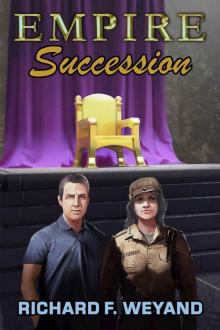 EMPIRE: Succession
EMPIRE: Succession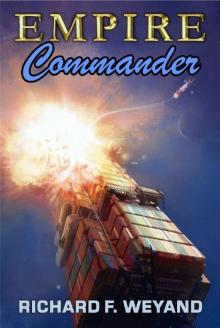 Commander
Commander QUANT (COLONY Book 1)
QUANT (COLONY Book 1) EMPIRE: Renewal
EMPIRE: Renewal GALACTIC SURVEY (COLONY Book 3)
GALACTIC SURVEY (COLONY Book 3) Campbell- The Problem With Bliss
Campbell- The Problem With Bliss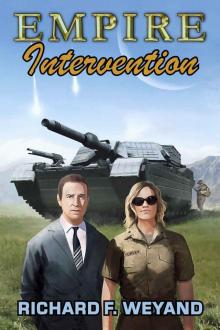 EMPIRE: Intervention (EMPIRE SERIES Book 13)
EMPIRE: Intervention (EMPIRE SERIES Book 13)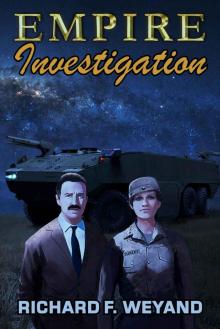 EMPIRE: Investigation
EMPIRE: Investigation A Charter for the Commonwealth
A Charter for the Commonwealth EMPIRE: Resistance
EMPIRE: Resistance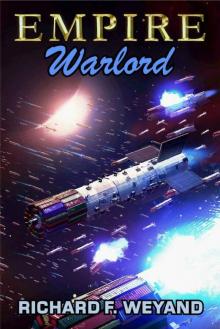 EMPIRE: Warlord (EMPIRE SERIES Book 5)
EMPIRE: Warlord (EMPIRE SERIES Book 5) EMPIRE: Resurgence
EMPIRE: Resurgence EMPIRE: Conqueror (EMPIRE SERIES Book 6)
EMPIRE: Conqueror (EMPIRE SERIES Book 6)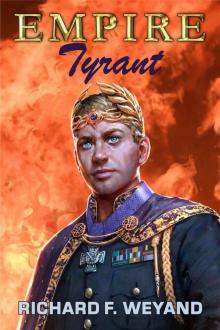 Tyrant
Tyrant Usurper
Usurper Galactic Mail: Revolution! (Childers Universe Book 3)
Galactic Mail: Revolution! (Childers Universe Book 3) Galactic Mail_Revolution!
Galactic Mail_Revolution! Childers
Childers CHILDERS_Absurd Proposals
CHILDERS_Absurd Proposals